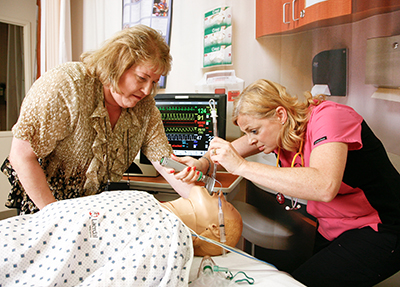High-tech simulation prepares medical providers

Hurt a store mannequin and it continues to grin, but tears can course down the rubber cheeks of its high-tech cousins used in medical simulation.
This and other human reactions transform these mannequins into valuable teachers for health care providers, allowing them to hone skills that help — even save — patients.
“If someone I loved had a heart attack, I would want the person helping to have the best chance of saving him or her, and I believe simulation training is key to saving lives,” says Staci Eguia, clinical nurse in MD Anderson’s Critical Care Unit. Eguia should know.
She has taken an advanced life support training course every two years since 1989. She also has received training in different places, giving her a broader experience base than most, since she started her career as a respiratory therapist in California.
She gives high marks to the instructors and mannequins in MD Anderson’s simulation center.
“You don’t pass the course offered here unless you know what to do and can demonstrate you can do it,” Eguia says. “They set really high standards for their instructors. The curriculum is thorough, and the simulation experiences are geared to how adults learn best.”
Until recently, doctors, nurses and other health care providers learned the art of medicine in the classroom and through the apprenticeship model. Working with more seasoned professionals, they watched and slowly built their skills through carefully observed interactions with patients.
Adding medical simulation to the learning equation has many benefits.
“There’s increasing evidence that the more practice a clinician has, the better he or she performs, and simulation is a safe and effective way to gain practice,” says Gregory Botz, M.D., professor in the Department of Critical Care and the physician leading MD Anderson’s simulation efforts through the Office of Performance Improvement.
You could learn a lot from a dummy
Anyone who has taken a basic cardiopulmonary resuscitation (CPR) course at MD Anderson has probably practiced on Annie, a mannequin introduced in 1960. While Annie still has a place in the simulation center, she’s one of many that range in size and complexity.
“We have high-fidelity mannequins that are controlled remotely by instructors, who can create a wide range of scenarios in which the mannequin displays symptoms — such as swelling of the throat and decreasing heart rate — that respond to the students’ actions,” says Ellen Pringle, education coordinator in the simulation center in the Department of Process Improvement and Quality Education.

Ellen Pringle watches as clinical nurse Staci Eguia
performs life-saving procedures on a dummy in
MD Anderson's new simulation center.
Photo: John Everett
“Mistakes are often a powerful teacher, and one important advantage is that simulation provides a safe environment where students can see the final result of their actions. If the outcome isn’t ideal, they can learn from it without harming anything or anyone,” she explains.
In addition to full-body mannequins, there are task trainers, which represent only part of the body, such as the spine, and are designed to teach specific tasks, like lumbar puncture.
There also is computer-based training, some of which connects to a mannequin as well. Simulated scenarios often are video recorded so instructors can review decisions and actions with students.
Much of the training is conducted in a new, 15,000-square-foot simulation facility. However, mock situations can be staged in the hospital and clinics using wireless mannequins.
And MD Anderson’s sophisticated da Vinci Robotic Surgical System used for several cancers has a simulator that allows physicians to practice when patients are not scheduled.
“Much like pilots aren’t allowed to fly until they complete a certain number of hours in a simulator, our surgeons can’t use the robot on patients until they master their skills in the simulator,” says Garrett Walsh, M.D., professor in the Department of Thoracic and Cardiovascular Surgery and head of Perioperative Enterprise.
He directed some of the funds from a generous donation by Jay Eisenberg, an associate member of MD Anderson’s Board of Visitors, and his wife, Lori, to the purchase of the simulator.
3-D images offer new dimension
While simulation will continue to focus on skills training, its use is expanding into areas such as team dynamics.
“Caring for patients is complex and often requires people with different expertise working together,” Botz says. “Inter-professional simulation goes beyond tasks to improving communication and teamwork.”
Walsh thinks this aspect is particularly helpful for surgeons. “Medical school and residency is so competitive that it can be difficult for those entering practice to shift to working as part of a team. But you’re not a lone ranger in the operating room, so practicing how to communicate and work effectively with others is critical for achieving the best outcome for patients.”
In the future, Annie and her pals may be replaced with the next generation of simulators: three-dimensional graphics, which allow students to virtually peel away layers of skin and muscle to see the inner workings of body structures and how they respond to student actions.
No matter where simulation goes in the future, it’s helping save lives today. “When I’m the one trying to save someone’s life, I know the practice I’ve gotten through simulation makes me more capable, so I place tremendous value on that training,” Eguia says.













